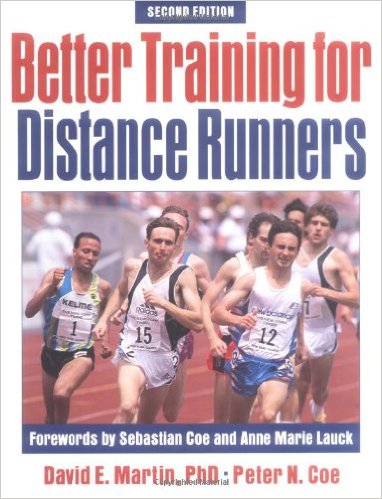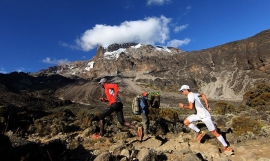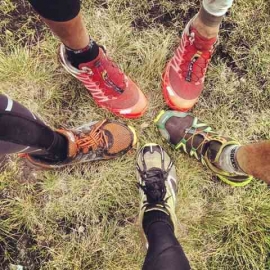David Martin出版的书籍:
The marathon footrace : performers and performances_David E Martin; Roger W H Gynn_1979
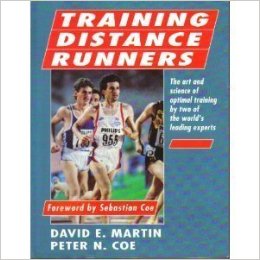
Training Distance Runners_David Martin_1994
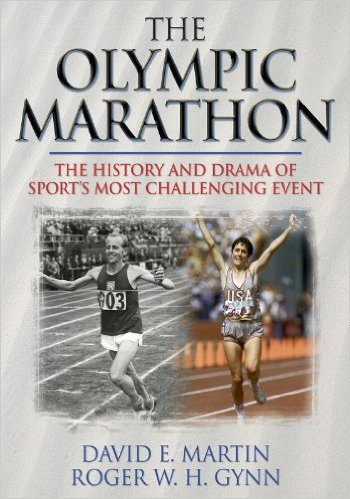
The Olympic Marathon_David Martin_2000
Better Training for Distance Runners 简介:
Better Training for Distance Runners provides a prescription for success for today`s competitive distance runners and their coaches. The book combines recent research, sound training principles, and proven program strategies to improve performance in events ranging from the 800-meters to the marathon.
Runners and coaches will find it easy to apply the book`s cutting-edge information about running physiology and biomechanics. They`ll receive straightforward advice for conditioning and competing in the whole range of distance events.
Better Training for Distance Runners Review
""""Better Training for Distance Runners is the complete manual for athletes, coaches, and educators. The book explains complicated issues and answers questions that lead to improved understanding of the art and science of distance running."""Keith A. BrantlyU.S. Team Member1996 Olympic Marathon """The first edition of Better Training for Distance Runners helped me make it to the 1996 Olympics and I believe this second edition can help me medal in the 2000 Olympics. The book allows runners to focus on specific events in distance running and explains the science of distance running in a manner that all distance runners can understand and use to their advantage. This really is a great book. I honestly was inspired to get out and train after each time I picked it up. I have worked with Dave Martin firsthand and everything I have learned from him is right here in this book. Dave is putting his love for distance running in the hands of the general public."""Mark J. CooganU.S. Team Member1996 Olympic Marathon "
Review
"Better Training for Distance Runners is the complete manual for athletes, coaches, and educators. The book explains complicated issues and answers questions that lead to improved understanding of the art and science of distance running."
Keith A. Brantly U.S. Team Member 1996 Olympic Marathon
"The first edition of Better Training for Distance Runners helped me make it to the 1996 Olympics and I believe this second edition can help me medal in the 2000 Olympics. The book allows runners to focus on specific events in distance running and explains the science of distance running in a manner that all distance runners can understand and use to their advantage. This really is a great book. I honestly was inspired to get out and train after each time I picked it up. I have worked with Dave Martin firsthand and everything I have learned from him is right here in this book. Dave is putting his love for distance running in the hands of the general public."
Mark J. Coogan U.S. Team Member 1996 Olympic Marathon
From the Publisher
"The first edition of Better Training for Distance Runners helped me make it to the 1996 Olympics and I believe this second edition can help me medal in the 2000 Olympics. This really is a great book. I was inspired to get out and train after each time I picked it up."
Mark J. Coogan U.S. Team Member 1996 Olympic Marathon
"Better Training for Distance Runners is the complete manual for athletes, coaches, and educators. The book explains complicated issues and answers questions that lead to improved understanding of the art and science of distance running."
Keith A. Brantly U.S. Team Member 1996 Olympic Marathon
"Dr. David Martin and Peter Coe’s vast knowledge of running is clearly demonstrated here. Dr. Martin makes even the most complex ideas easily understandable. He and Peter Coe have added another brilliant volume in the scientific approach and theory of how to train. This book will be your complete source to being competitive in the years to come."
Jim Spivey
U.S. Olympic Team Member 1500 Meters, 1984 & 1992 5000 Meters, 1996
About the Author
No two authors are better qualified than David Martin and Peter Coe to address both the physiology and coaching of distance running. Martin has served as marathon chair of USA Track & Field`s (USATF) Men`s Development Committee since 1979 and as chair of the national governing body`s Sport Science Subcommittee since 1984. These positions have allowed him to coach, advise, and scientifically evaluate many of America`s best men and women distance runners. They have also provided him the opportunity to work with and learn from other top coaches and sports scientists around the world. A fellow of the American College of Sports Medicine, Martin is the author of four books, including The High Jump Book, The Marathon Footrace, and Training Distance Runners. He also is a contributor to New Studies in Athletics, the technical journal of the International Amateur Athletic Federation.
Dr. Martin is a regents professor of health sciences at Georgia State University, which has three times honored him as a distinguished professor. He is also a results statistician for the Association of International Marathons and the Association for Track & Field Statisticians.
Peter Coe has successfully coached domestic and foreign runners at all levels, but he is probably best known for guiding his son Sebastian to one of the greatest middle distance running careers of all time. Under Peter`s tutelage, Sebastian won two Olympic gold medals in the 1500-meter run and two Olympic silver medals in the 800-meter run; a bronze, a silver, and a gold at the European championships; and 12 world records. A retired engineer, Coe is a recognized international lecturer and a writer. He is author of Training Distance Runners and Winning Running. Coe was presented the Senior Coaching Award by the British Athletics Association and was named Coach of the Year by the British Milers` Club—an organization for which he served as chairman for several years.
I have read dozens of books about training for the distance runner. This book and Jack Daniel's Running Formula are, by far, the two best books for the serious coach or distance runner. I believe they complement each other and reading BTDR after Daniel's Running Formula helped clarify some of the points made in the Daniel's book. After years of running at a highly competitive level and coaching, I really felt like I understood, for the first time, exactly how to design an individualized workout plan for an entire year or racing season with complete confidence.
While the first four chapters are not for the feint of heart (especially chapters 3 and 4), they are well worth the effort. Even if you choose not to read one or more of these chapters, the remaining chapters of BTDR can be read on a standalone basis. Chapters 5 - 8 are filled with clear, comprehensive and practical training advice. These chapters do an excellent job of bringing theory and practice together.
I also liked the way Martin and Coe drew on the training practices and running styles of various famous runners and coaches from Paavo Nurmi to Arthyr Llydiard to Haile Gebrselassie. (Of course, Seb Coe's training methods are discussed quite extensively since Peter Coe was both father and coach... and Seb was the best middle distance runner of his time.)
BTDR also deftly combines a discussion of the art and science of running. If you are a serious runner, this book will likely convince you to periodically take your runners or yourself to a human performance lab to receive periodic testing.
The only significant omission from BTDR was a more complete discussion of the effects of altitude training. They don't discuss the benefits of the "living high/training low" (sleeping or living in an hypoxic environment and training at or near sea level). Because the book was revised in 1991, I imagine most of the scientific data on this subject was not available at that time. This discussion would be helpful in their discussion of how to increase hemoglobin and hematocrit.
I wish they would update this book one more time to cover some of the scientific advances over the past 15 years.
This book is tailored toward a small group of people, namely very serious competitive runners who plan to manage a successful running career. It is not for the weekend warrior who runs to lose weight, someone trying to run their first marathon, or attention deficit high school students who get discouraged because of the vast scientific knowledge contained in this book. It is a thoroughly researched, brilliantly done, scientifically based work that is probably the most complete book on competitive running ever compiled. I especially loved the fact of the 800m race being included in the strategy section, as a serious 800/1600m athlete is often left without advice on how to run the half, one of the most challenging yet neglected distance events. If you are serious, OR if you are mainly a 800m and 1600m runner as I am, then buy this book, otherwise purchase the Daniels Running Formula, the other `best' running book ever written.
Better Training for Distance Runners 亚马逊读者评论:
The purpose of the book is to be a comprehensive guide to training distance runners. If you are serious about your efforts in fulfilling your potential as a runner you will need to address all aspects of training. For some that may mean having a scientific fundamental understanding of how the body responds to training. I'm sorry that some of the reviewers may not appreciate the first 4 chapters of the book, which focuses on the physiology of running. Running, like any athletic activity, is about training the body's energy systems. Racing 100 meter requires a different energy system than racing a marathon. Thus training for 800 meters is different than training for 5000 meters. That is why in BTDR you get basic physiology first and training theory second. You can understand the book better if you start from this basic premise. You will understand why running 5 miles at certain speeds will have different effects or how to peak for a racing for a certain period of time. The science aspect makes the book a tough read, but the real value is Chapters 5-8. If the book were to contain only the last five chapters then it would still be valuable. Yes, a basic understanding of science is needed for the first four chapters. However, I find it hard to believe that concepts developed in the later chapters like periodization, total body fitness, race strategies, and training management were not of value to some of the reviewers. Newton give cursory treatment to these subjects, Jack Daniels does a better job in his 'Running Formula' (and would be the book that I would recommend to all high school distance runners), but it's BTDR that really breaks it down. BDTR will get you thinking in a whole new way about your approach to running.
I have to also say a word about the expectation that popular running books created for runner eager to learn more about training. Publications like Runner's World and the Running Times are known for their easy to understand training articles that outline how to get faster. Their publishers also publish books in this same vain. What is not questioned are the training philosophies behind the programs, its just a successful runner (active or retired) or coach giving the cliff notes version of their programs. I'm sorry, but a week in the life of Runner X does me no good if I can't understand where that week is in his/her training, why they are doing what they are doing (re: goals) and most importantly their training philosophy. I applaud the fact that they are reaching a vast audience of runner who really don't want to run a sub 4:00 mile (and that is needed), but I do. BTDR is not meant for them. Glover's book ' the Competitive Runners Guide...' is a good starting point but it is more useful to a beginner runner than a high school cross-country runner (different races different goals). This simplification has its drawbacks; it encourages the simple parroting of training programs without a full understanding of their impact. Do you peak for one racing period, two periods or cycle the program? How long should base training last? When do we introduce anaerobic capacity training? Important questions to a serious runner but a less focused runner could care less. BDTR is meant for those who wish to learn how to develop thier own training programs from scratch. Which means gaining a fundamental understanding of every aspect of training runners. It not enough to say run 10 miles on Sunday as your weekly long run. Why not 5 miles or 20 miles? Is it even worth doing one at all? These questions answered in BTDR and not answered in most other popular running books.
This book is not for every one. A high school runner may not want to know what the aerobic energy system is or how it works. Furthermore, s/he may not even care. Any one can tell some one to run 10 miles one day and 12x400m repeats the next, but if they can't tell you why you are doing that or what effect it will have on you then why would you want to give up your time and effort. For those that do have an interest and want to know what it takes to get to the next level then this book is gold.
Bottom line. If you are not serious about your running then this book is not for you.

